Economics Assignment: Macroeconomic Analysis of Australia (2001-2016)
VerifiedAdded on 2021/05/27
|12
|1607
|79
Report
AI Summary
This economics assignment analyzes the trends in inflation and unemployment rates in Australia from 2001 to 2016, examining their relationship and interpreting it through the lens of the Phillips Curve theory. The report further delves into the macroeconomic framework of aggregate demand and aggregate supply, evaluating the effects of various economic events, such as tariffs on chickpea exports, increased demand for Australian wine, government spending on electric power, changes in oil prices, and immigration, on the real GDP and price levels in Australia. The analysis includes graphical representations and explanations to illustrate the impact of these factors on the Australian economy, providing a comprehensive overview of macroeconomic dynamics.
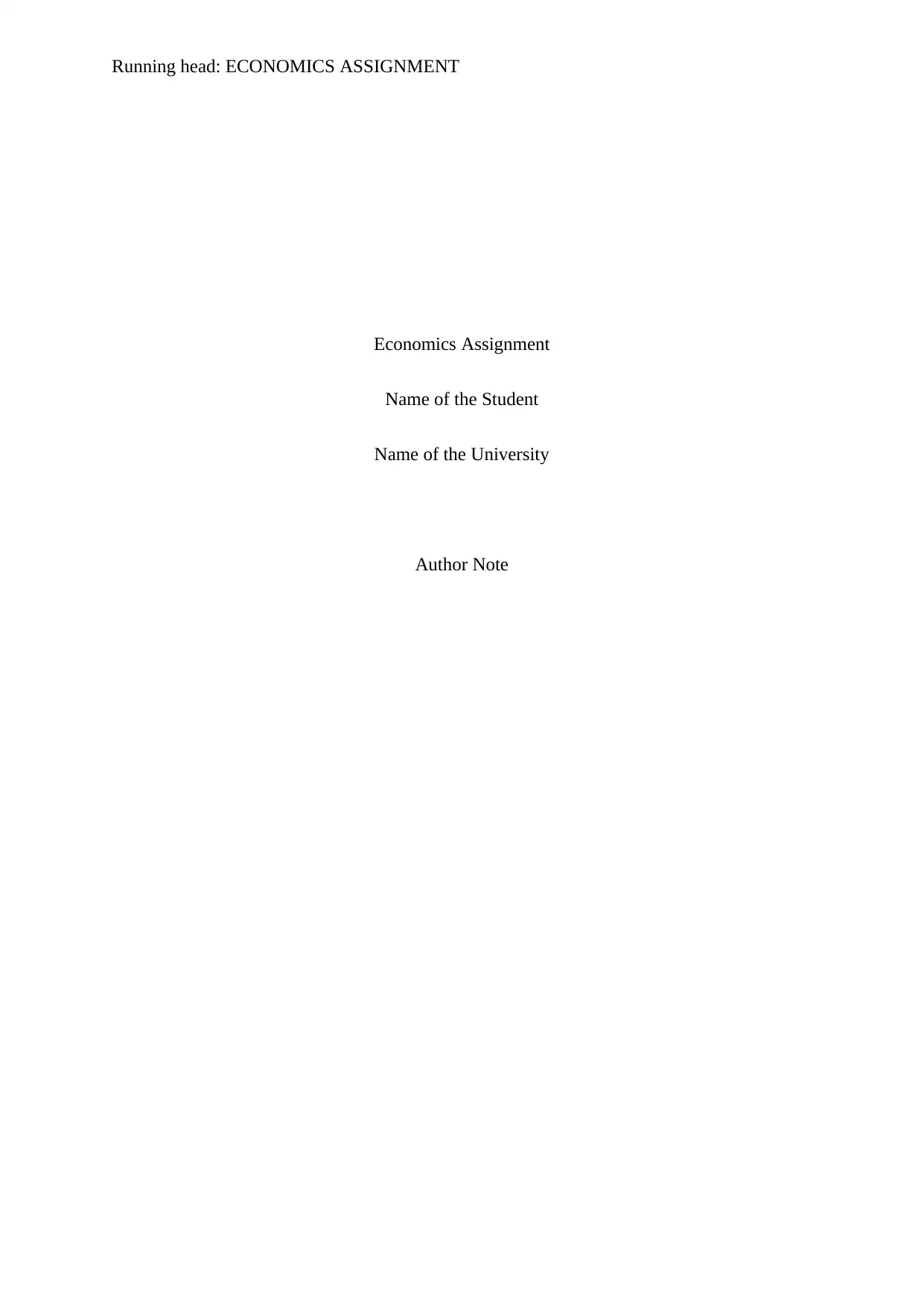
Running head: ECONOMICS ASSIGNMENT
Economics Assignment
Name of the Student
Name of the University
Author Note
Economics Assignment
Name of the Student
Name of the University
Author Note
Paraphrase This Document
Need a fresh take? Get an instant paraphrase of this document with our AI Paraphraser
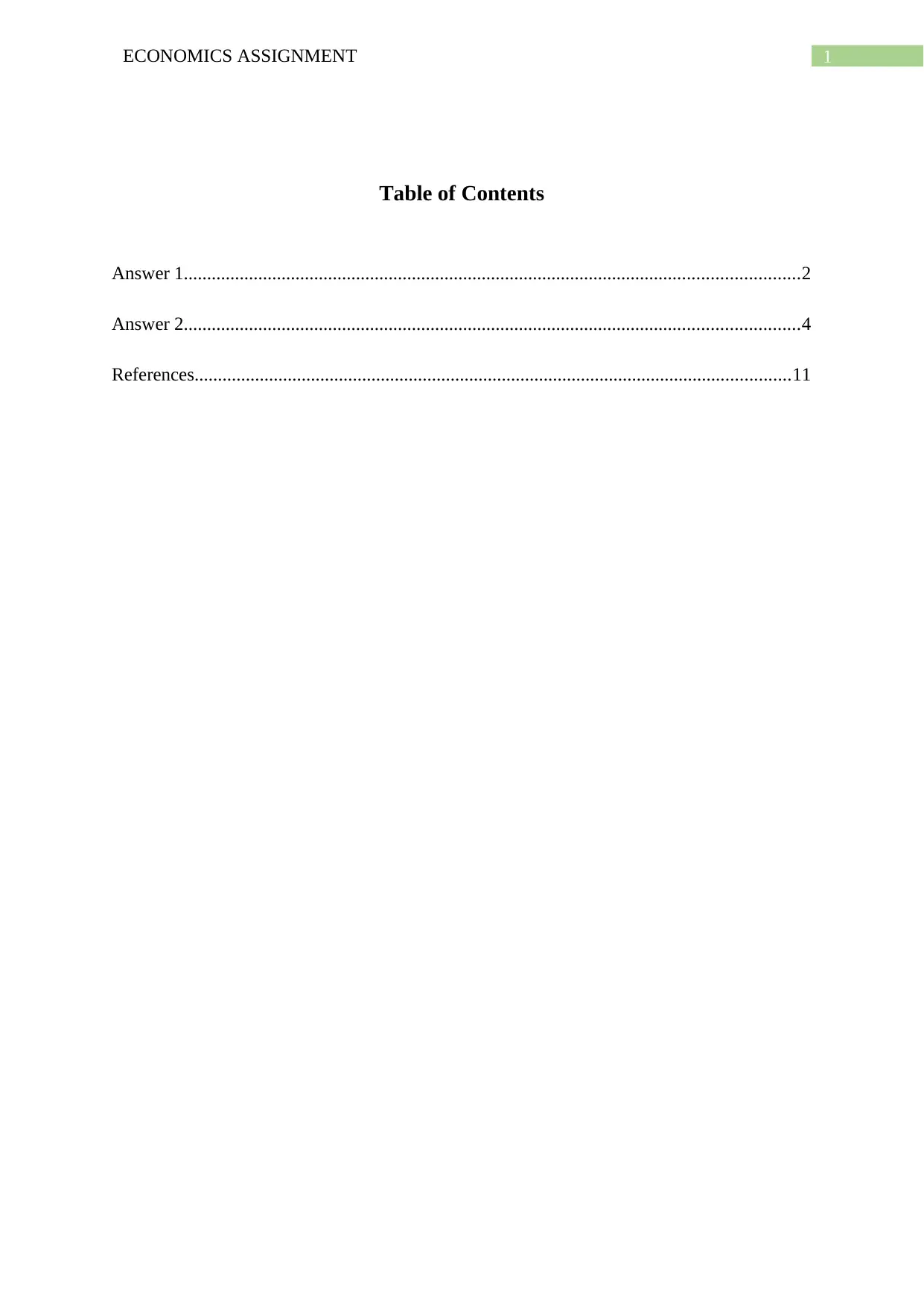
1ECONOMICS ASSIGNMENT
Table of Contents
Answer 1....................................................................................................................................2
Answer 2....................................................................................................................................4
References................................................................................................................................11
Table of Contents
Answer 1....................................................................................................................................2
Answer 2....................................................................................................................................4
References................................................................................................................................11
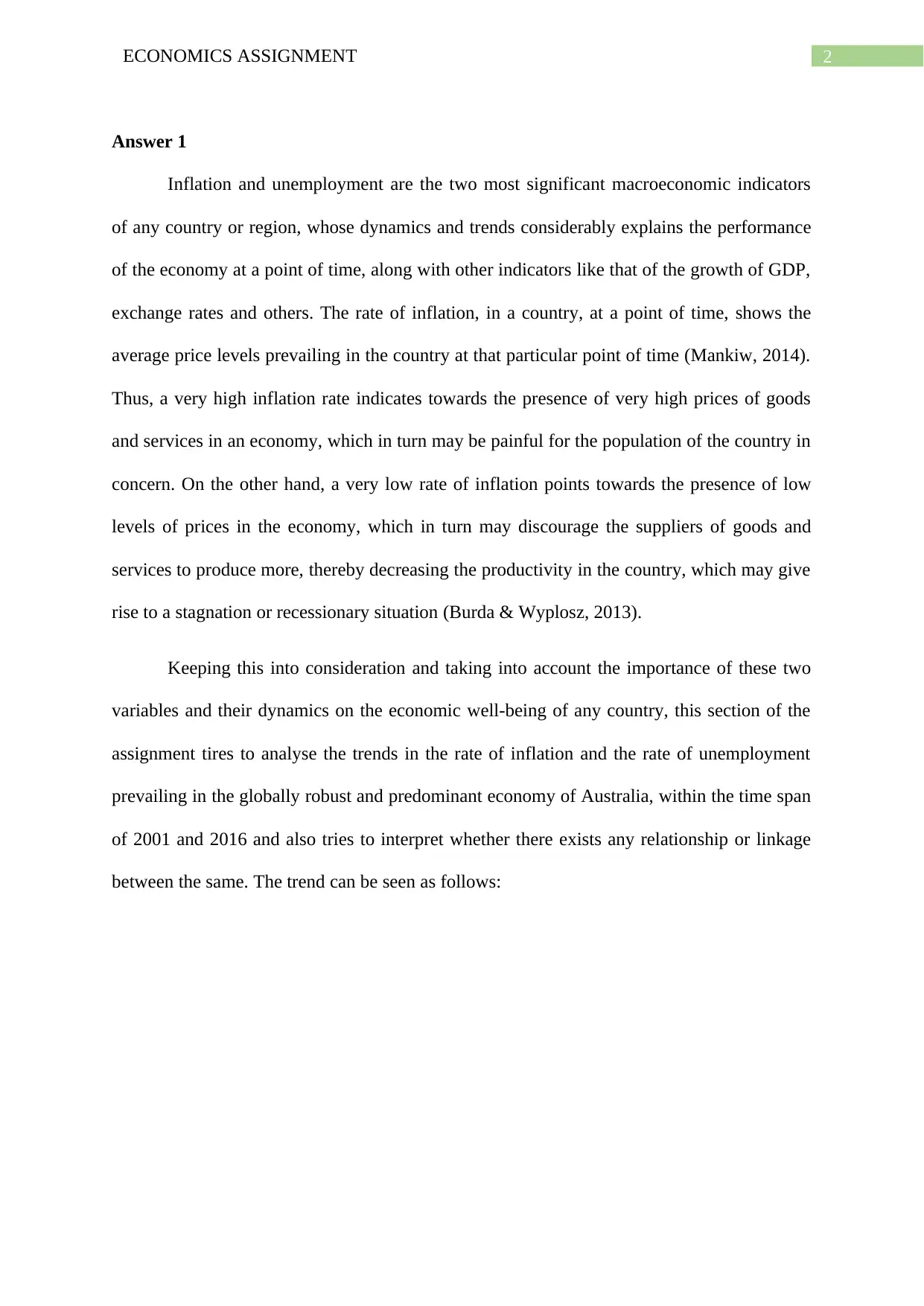
2ECONOMICS ASSIGNMENT
Answer 1
Inflation and unemployment are the two most significant macroeconomic indicators
of any country or region, whose dynamics and trends considerably explains the performance
of the economy at a point of time, along with other indicators like that of the growth of GDP,
exchange rates and others. The rate of inflation, in a country, at a point of time, shows the
average price levels prevailing in the country at that particular point of time (Mankiw, 2014).
Thus, a very high inflation rate indicates towards the presence of very high prices of goods
and services in an economy, which in turn may be painful for the population of the country in
concern. On the other hand, a very low rate of inflation points towards the presence of low
levels of prices in the economy, which in turn may discourage the suppliers of goods and
services to produce more, thereby decreasing the productivity in the country, which may give
rise to a stagnation or recessionary situation (Burda & Wyplosz, 2013).
Keeping this into consideration and taking into account the importance of these two
variables and their dynamics on the economic well-being of any country, this section of the
assignment tires to analyse the trends in the rate of inflation and the rate of unemployment
prevailing in the globally robust and predominant economy of Australia, within the time span
of 2001 and 2016 and also tries to interpret whether there exists any relationship or linkage
between the same. The trend can be seen as follows:
Answer 1
Inflation and unemployment are the two most significant macroeconomic indicators
of any country or region, whose dynamics and trends considerably explains the performance
of the economy at a point of time, along with other indicators like that of the growth of GDP,
exchange rates and others. The rate of inflation, in a country, at a point of time, shows the
average price levels prevailing in the country at that particular point of time (Mankiw, 2014).
Thus, a very high inflation rate indicates towards the presence of very high prices of goods
and services in an economy, which in turn may be painful for the population of the country in
concern. On the other hand, a very low rate of inflation points towards the presence of low
levels of prices in the economy, which in turn may discourage the suppliers of goods and
services to produce more, thereby decreasing the productivity in the country, which may give
rise to a stagnation or recessionary situation (Burda & Wyplosz, 2013).
Keeping this into consideration and taking into account the importance of these two
variables and their dynamics on the economic well-being of any country, this section of the
assignment tires to analyse the trends in the rate of inflation and the rate of unemployment
prevailing in the globally robust and predominant economy of Australia, within the time span
of 2001 and 2016 and also tries to interpret whether there exists any relationship or linkage
between the same. The trend can be seen as follows:
⊘ This is a preview!⊘
Do you want full access?
Subscribe today to unlock all pages.

Trusted by 1+ million students worldwide
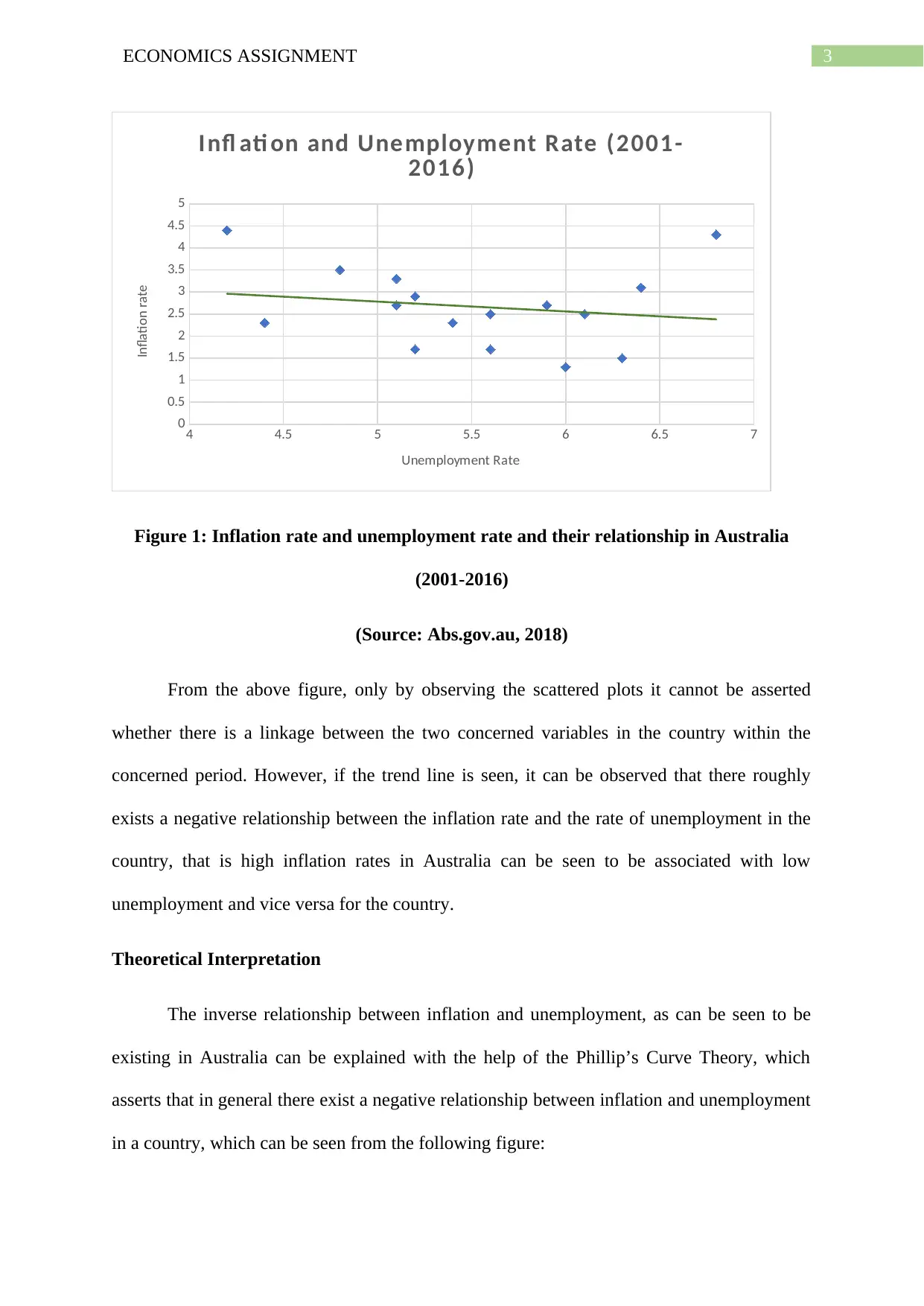
3ECONOMICS ASSIGNMENT
4 4.5 5 5.5 6 6.5 7
0
0.5
1
1.5
2
2.5
3
3.5
4
4.5
5
Infl ati on and Unemployment Rate (2001-
2016)
Unemployment Rate
Inflation rate
Figure 1: Inflation rate and unemployment rate and their relationship in Australia
(2001-2016)
(Source: Abs.gov.au, 2018)
From the above figure, only by observing the scattered plots it cannot be asserted
whether there is a linkage between the two concerned variables in the country within the
concerned period. However, if the trend line is seen, it can be observed that there roughly
exists a negative relationship between the inflation rate and the rate of unemployment in the
country, that is high inflation rates in Australia can be seen to be associated with low
unemployment and vice versa for the country.
Theoretical Interpretation
The inverse relationship between inflation and unemployment, as can be seen to be
existing in Australia can be explained with the help of the Phillip’s Curve Theory, which
asserts that in general there exist a negative relationship between inflation and unemployment
in a country, which can be seen from the following figure:
4 4.5 5 5.5 6 6.5 7
0
0.5
1
1.5
2
2.5
3
3.5
4
4.5
5
Infl ati on and Unemployment Rate (2001-
2016)
Unemployment Rate
Inflation rate
Figure 1: Inflation rate and unemployment rate and their relationship in Australia
(2001-2016)
(Source: Abs.gov.au, 2018)
From the above figure, only by observing the scattered plots it cannot be asserted
whether there is a linkage between the two concerned variables in the country within the
concerned period. However, if the trend line is seen, it can be observed that there roughly
exists a negative relationship between the inflation rate and the rate of unemployment in the
country, that is high inflation rates in Australia can be seen to be associated with low
unemployment and vice versa for the country.
Theoretical Interpretation
The inverse relationship between inflation and unemployment, as can be seen to be
existing in Australia can be explained with the help of the Phillip’s Curve Theory, which
asserts that in general there exist a negative relationship between inflation and unemployment
in a country, which can be seen from the following figure:
Paraphrase This Document
Need a fresh take? Get an instant paraphrase of this document with our AI Paraphraser
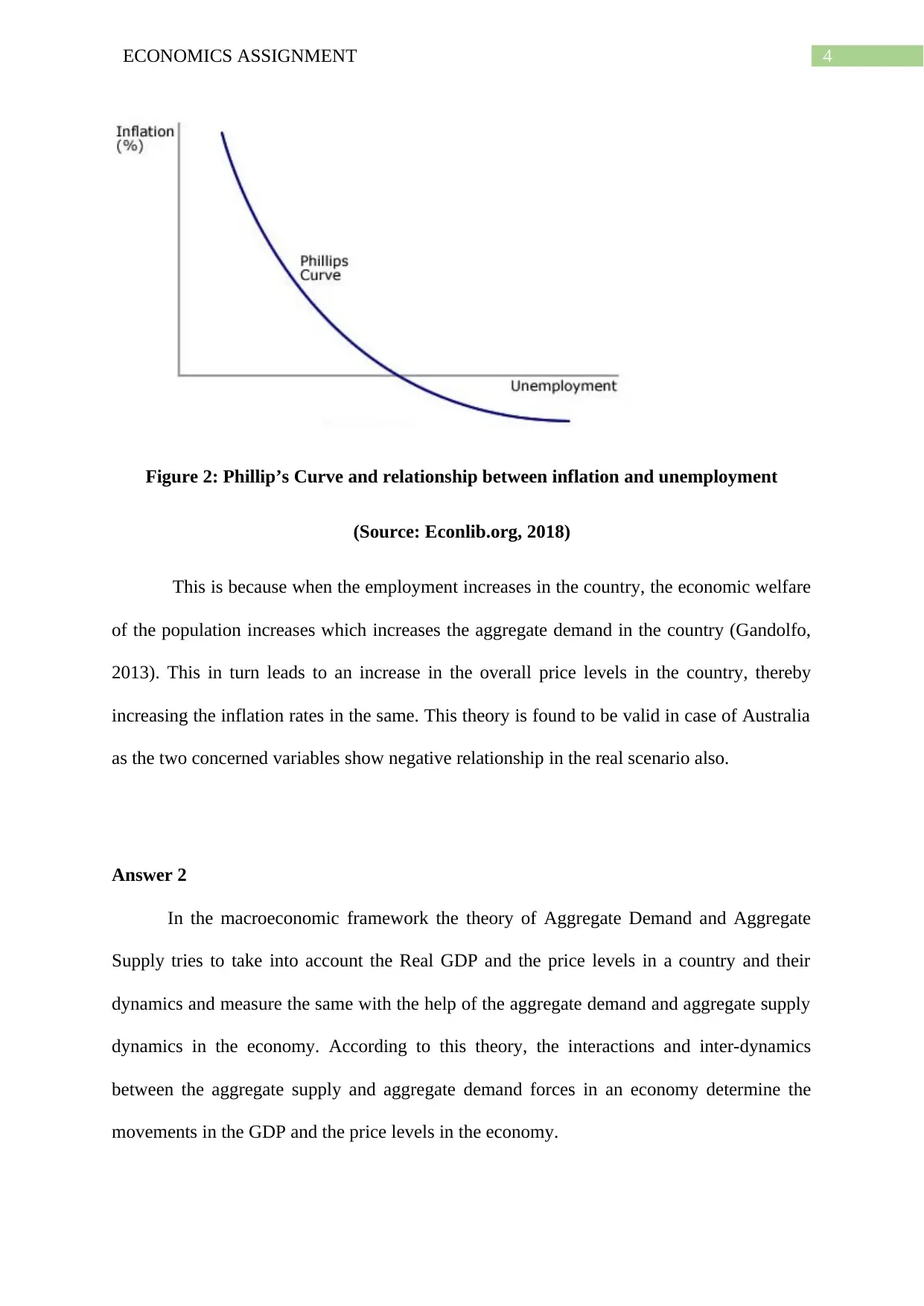
4ECONOMICS ASSIGNMENT
Figure 2: Phillip’s Curve and relationship between inflation and unemployment
(Source: Econlib.org, 2018)
This is because when the employment increases in the country, the economic welfare
of the population increases which increases the aggregate demand in the country (Gandolfo,
2013). This in turn leads to an increase in the overall price levels in the country, thereby
increasing the inflation rates in the same. This theory is found to be valid in case of Australia
as the two concerned variables show negative relationship in the real scenario also.
Answer 2
In the macroeconomic framework the theory of Aggregate Demand and Aggregate
Supply tries to take into account the Real GDP and the price levels in a country and their
dynamics and measure the same with the help of the aggregate demand and aggregate supply
dynamics in the economy. According to this theory, the interactions and inter-dynamics
between the aggregate supply and aggregate demand forces in an economy determine the
movements in the GDP and the price levels in the economy.
Figure 2: Phillip’s Curve and relationship between inflation and unemployment
(Source: Econlib.org, 2018)
This is because when the employment increases in the country, the economic welfare
of the population increases which increases the aggregate demand in the country (Gandolfo,
2013). This in turn leads to an increase in the overall price levels in the country, thereby
increasing the inflation rates in the same. This theory is found to be valid in case of Australia
as the two concerned variables show negative relationship in the real scenario also.
Answer 2
In the macroeconomic framework the theory of Aggregate Demand and Aggregate
Supply tries to take into account the Real GDP and the price levels in a country and their
dynamics and measure the same with the help of the aggregate demand and aggregate supply
dynamics in the economy. According to this theory, the interactions and inter-dynamics
between the aggregate supply and aggregate demand forces in an economy determine the
movements in the GDP and the price levels in the economy.
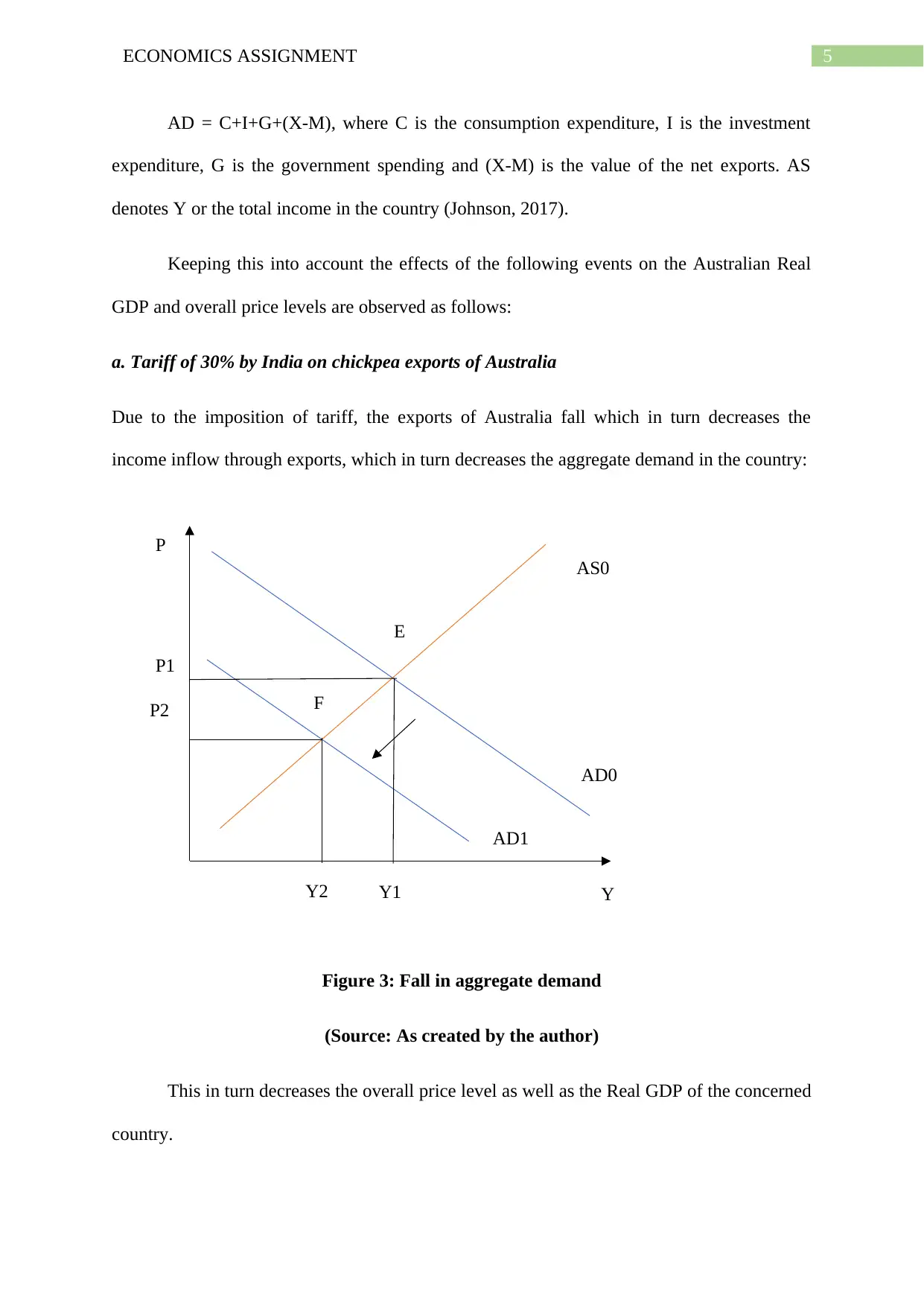
5ECONOMICS ASSIGNMENT
P
P1
P2
Y2 Y1 Y
AS0
AD1
AD0
F
E
AD = C+I+G+(X-M), where C is the consumption expenditure, I is the investment
expenditure, G is the government spending and (X-M) is the value of the net exports. AS
denotes Y or the total income in the country (Johnson, 2017).
Keeping this into account the effects of the following events on the Australian Real
GDP and overall price levels are observed as follows:
a. Tariff of 30% by India on chickpea exports of Australia
Due to the imposition of tariff, the exports of Australia fall which in turn decreases the
income inflow through exports, which in turn decreases the aggregate demand in the country:
Figure 3: Fall in aggregate demand
(Source: As created by the author)
This in turn decreases the overall price level as well as the Real GDP of the concerned
country.
P
P1
P2
Y2 Y1 Y
AS0
AD1
AD0
F
E
AD = C+I+G+(X-M), where C is the consumption expenditure, I is the investment
expenditure, G is the government spending and (X-M) is the value of the net exports. AS
denotes Y or the total income in the country (Johnson, 2017).
Keeping this into account the effects of the following events on the Australian Real
GDP and overall price levels are observed as follows:
a. Tariff of 30% by India on chickpea exports of Australia
Due to the imposition of tariff, the exports of Australia fall which in turn decreases the
income inflow through exports, which in turn decreases the aggregate demand in the country:
Figure 3: Fall in aggregate demand
(Source: As created by the author)
This in turn decreases the overall price level as well as the Real GDP of the concerned
country.
⊘ This is a preview!⊘
Do you want full access?
Subscribe today to unlock all pages.

Trusted by 1+ million students worldwide
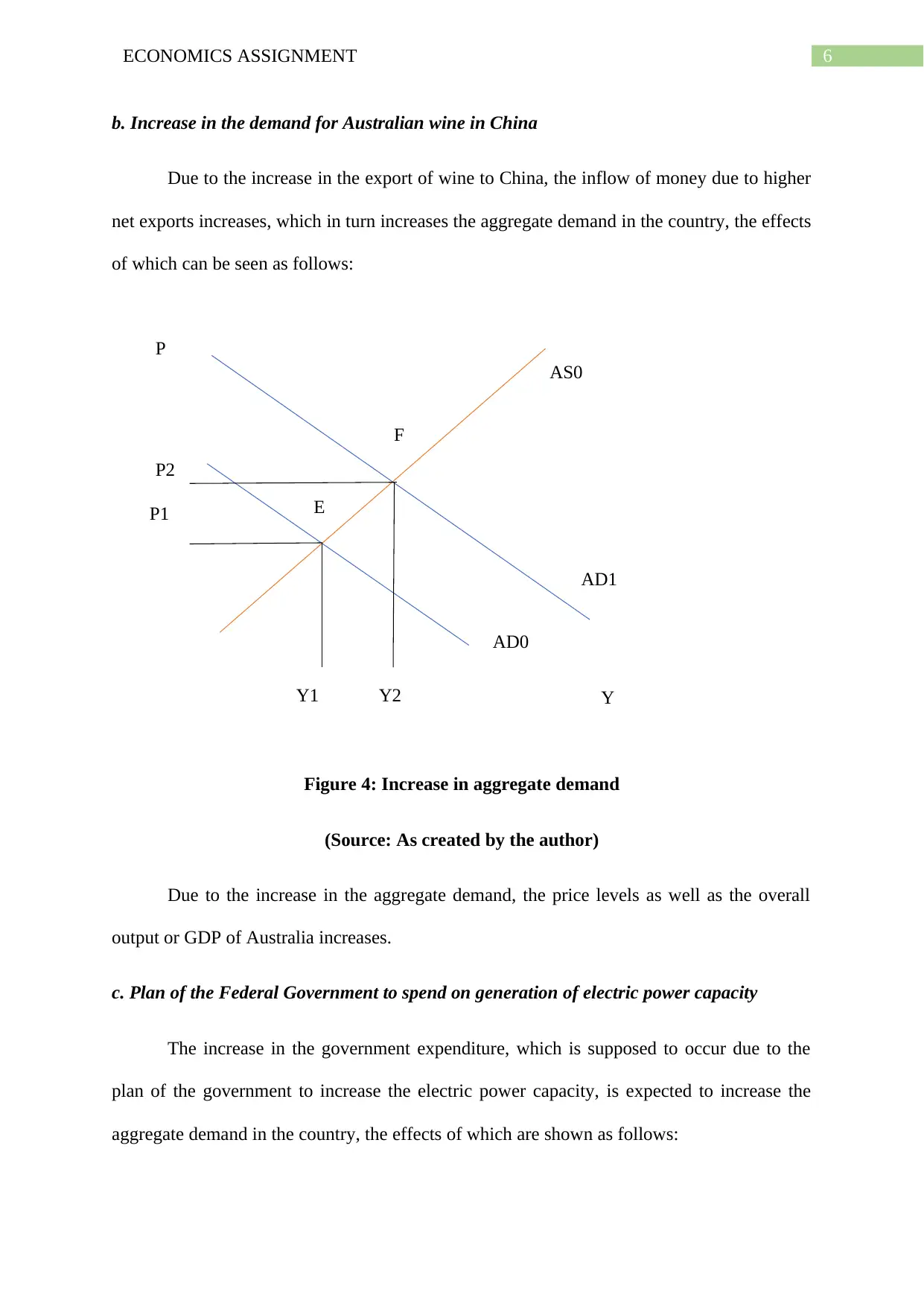
6ECONOMICS ASSIGNMENT
P
P2
P1
Y1 Y2 Y
AS0
AD0
AD1
E
F
b. Increase in the demand for Australian wine in China
Due to the increase in the export of wine to China, the inflow of money due to higher
net exports increases, which in turn increases the aggregate demand in the country, the effects
of which can be seen as follows:
Figure 4: Increase in aggregate demand
(Source: As created by the author)
Due to the increase in the aggregate demand, the price levels as well as the overall
output or GDP of Australia increases.
c. Plan of the Federal Government to spend on generation of electric power capacity
The increase in the government expenditure, which is supposed to occur due to the
plan of the government to increase the electric power capacity, is expected to increase the
aggregate demand in the country, the effects of which are shown as follows:
P
P2
P1
Y1 Y2 Y
AS0
AD0
AD1
E
F
b. Increase in the demand for Australian wine in China
Due to the increase in the export of wine to China, the inflow of money due to higher
net exports increases, which in turn increases the aggregate demand in the country, the effects
of which can be seen as follows:
Figure 4: Increase in aggregate demand
(Source: As created by the author)
Due to the increase in the aggregate demand, the price levels as well as the overall
output or GDP of Australia increases.
c. Plan of the Federal Government to spend on generation of electric power capacity
The increase in the government expenditure, which is supposed to occur due to the
plan of the government to increase the electric power capacity, is expected to increase the
aggregate demand in the country, the effects of which are shown as follows:
Paraphrase This Document
Need a fresh take? Get an instant paraphrase of this document with our AI Paraphraser
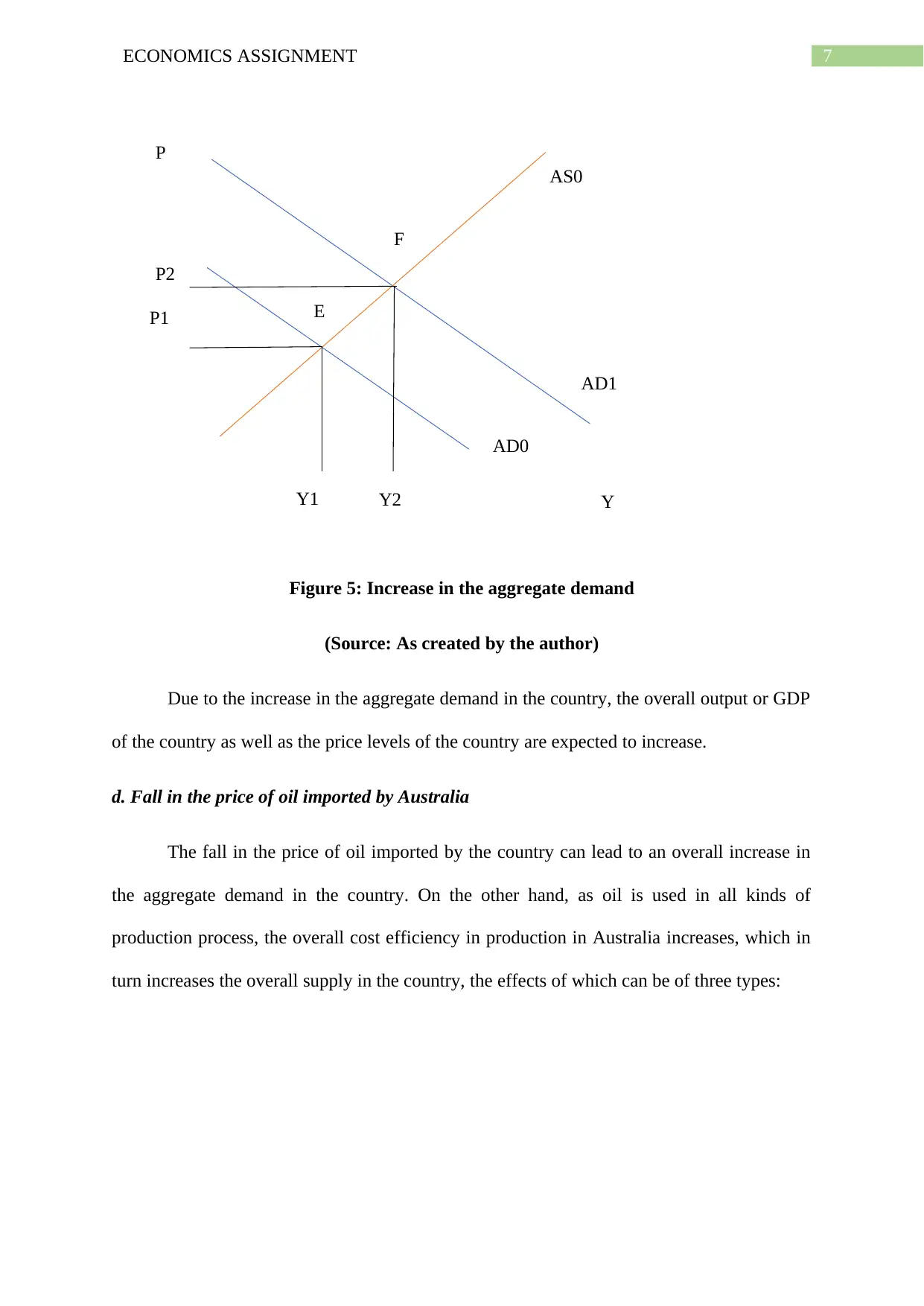
7ECONOMICS ASSIGNMENT
P
P2
P1
Y1 Y2 Y
AS0
AD0
AD1
E
F
Figure 5: Increase in the aggregate demand
(Source: As created by the author)
Due to the increase in the aggregate demand in the country, the overall output or GDP
of the country as well as the price levels of the country are expected to increase.
d. Fall in the price of oil imported by Australia
The fall in the price of oil imported by the country can lead to an overall increase in
the aggregate demand in the country. On the other hand, as oil is used in all kinds of
production process, the overall cost efficiency in production in Australia increases, which in
turn increases the overall supply in the country, the effects of which can be of three types:
P
P2
P1
Y1 Y2 Y
AS0
AD0
AD1
E
F
Figure 5: Increase in the aggregate demand
(Source: As created by the author)
Due to the increase in the aggregate demand in the country, the overall output or GDP
of the country as well as the price levels of the country are expected to increase.
d. Fall in the price of oil imported by Australia
The fall in the price of oil imported by the country can lead to an overall increase in
the aggregate demand in the country. On the other hand, as oil is used in all kinds of
production process, the overall cost efficiency in production in Australia increases, which in
turn increases the overall supply in the country, the effects of which can be of three types:
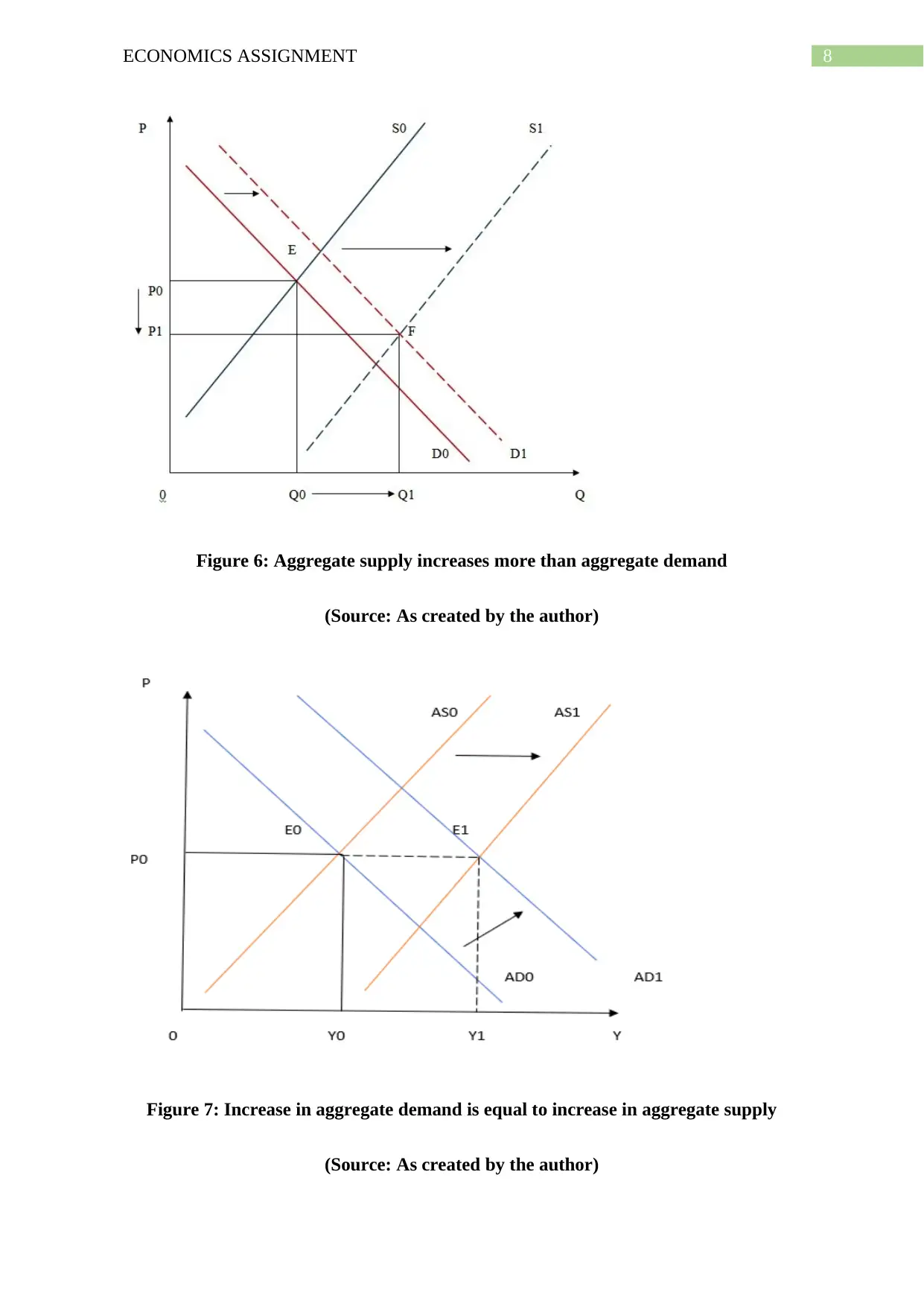
8ECONOMICS ASSIGNMENT
Figure 6: Aggregate supply increases more than aggregate demand
(Source: As created by the author)
Figure 7: Increase in aggregate demand is equal to increase in aggregate supply
(Source: As created by the author)
Figure 6: Aggregate supply increases more than aggregate demand
(Source: As created by the author)
Figure 7: Increase in aggregate demand is equal to increase in aggregate supply
(Source: As created by the author)
⊘ This is a preview!⊘
Do you want full access?
Subscribe today to unlock all pages.

Trusted by 1+ million students worldwide
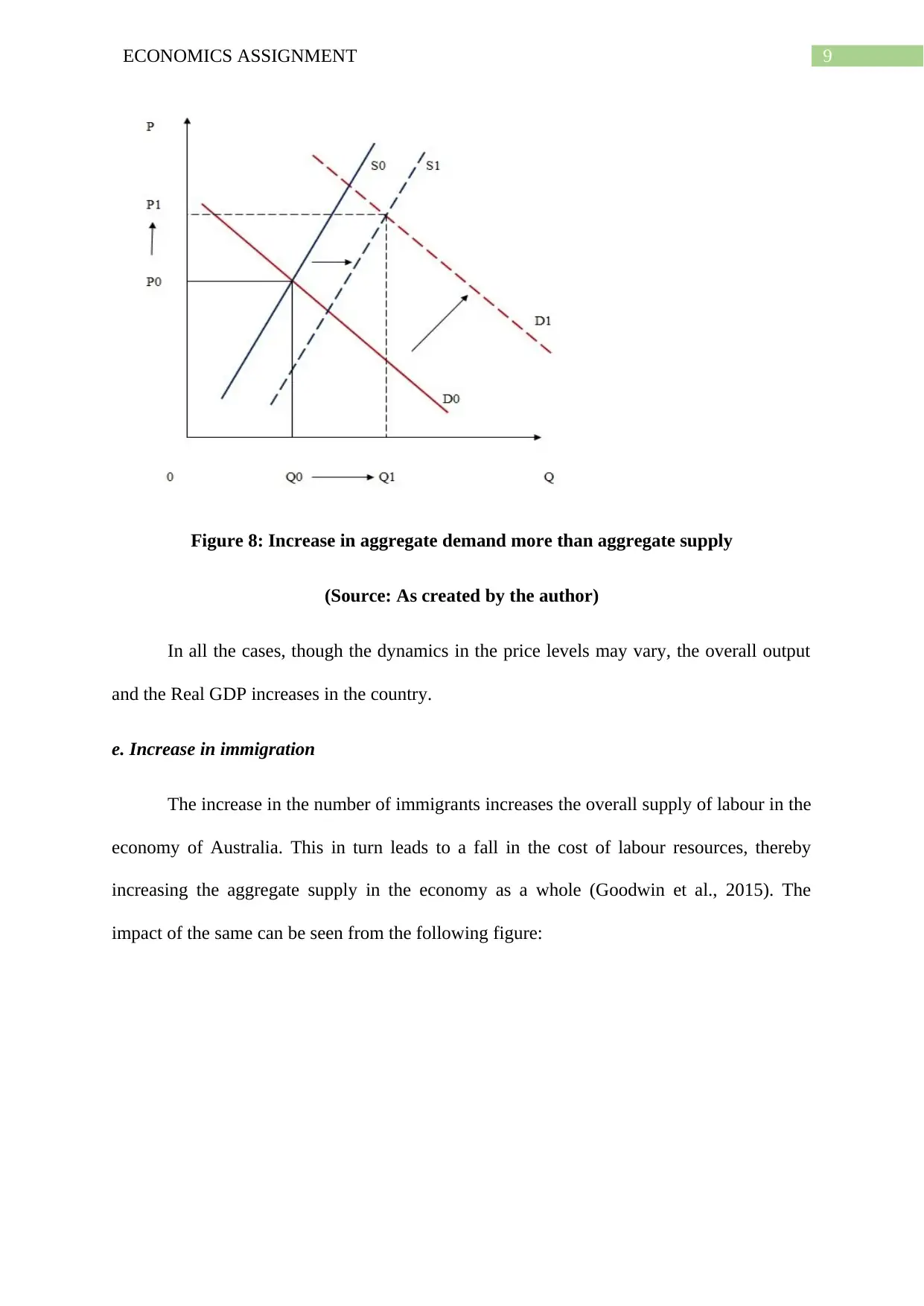
9ECONOMICS ASSIGNMENT
Figure 8: Increase in aggregate demand more than aggregate supply
(Source: As created by the author)
In all the cases, though the dynamics in the price levels may vary, the overall output
and the Real GDP increases in the country.
e. Increase in immigration
The increase in the number of immigrants increases the overall supply of labour in the
economy of Australia. This in turn leads to a fall in the cost of labour resources, thereby
increasing the aggregate supply in the economy as a whole (Goodwin et al., 2015). The
impact of the same can be seen from the following figure:
Figure 8: Increase in aggregate demand more than aggregate supply
(Source: As created by the author)
In all the cases, though the dynamics in the price levels may vary, the overall output
and the Real GDP increases in the country.
e. Increase in immigration
The increase in the number of immigrants increases the overall supply of labour in the
economy of Australia. This in turn leads to a fall in the cost of labour resources, thereby
increasing the aggregate supply in the economy as a whole (Goodwin et al., 2015). The
impact of the same can be seen from the following figure:
Paraphrase This Document
Need a fresh take? Get an instant paraphrase of this document with our AI Paraphraser
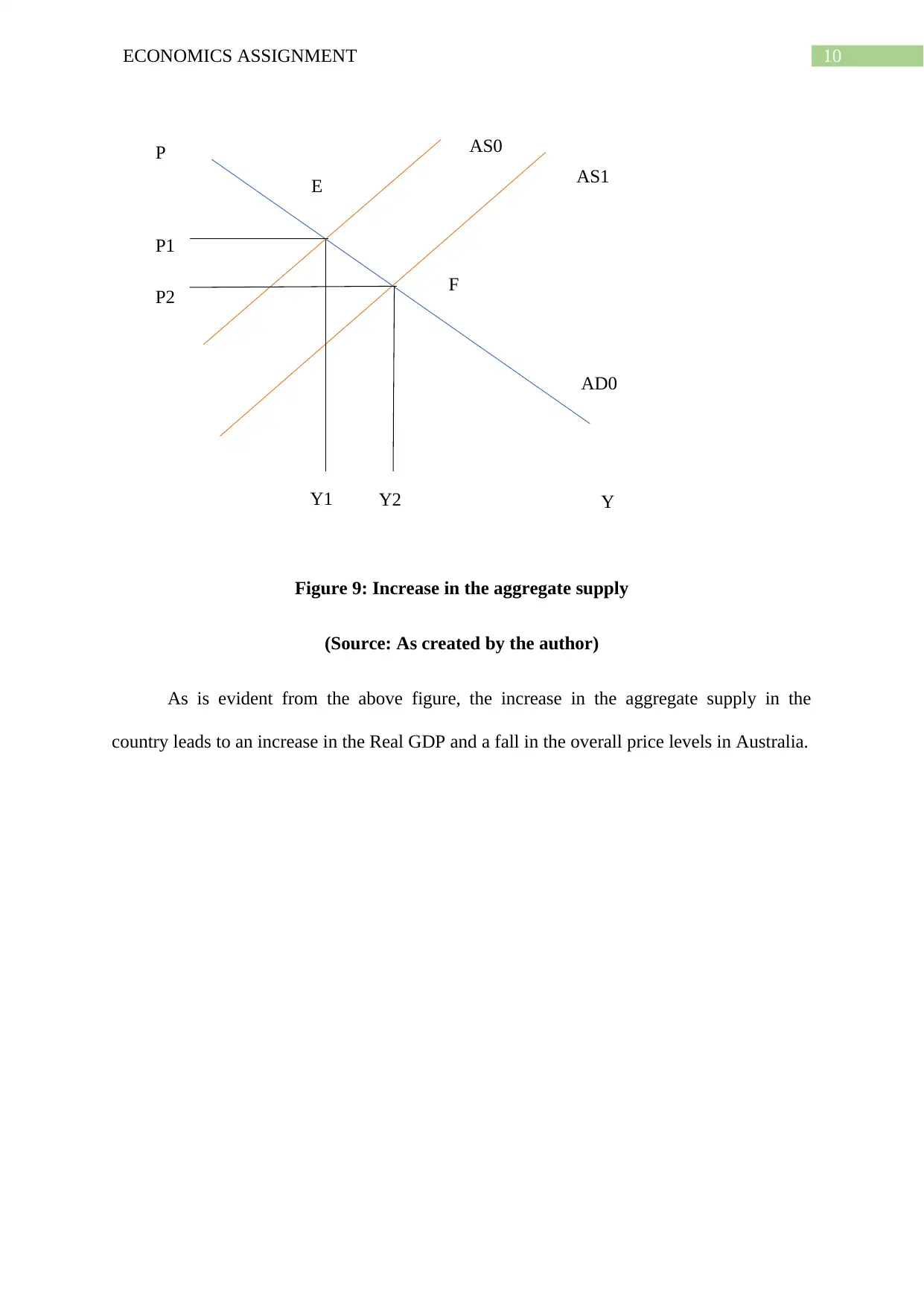
10ECONOMICS ASSIGNMENT
P
P1
P2
Y1 Y2 Y
AS0
AS1
AD0
F
E
Figure 9: Increase in the aggregate supply
(Source: As created by the author)
As is evident from the above figure, the increase in the aggregate supply in the
country leads to an increase in the Real GDP and a fall in the overall price levels in Australia.
P
P1
P2
Y1 Y2 Y
AS0
AS1
AD0
F
E
Figure 9: Increase in the aggregate supply
(Source: As created by the author)
As is evident from the above figure, the increase in the aggregate supply in the
country leads to an increase in the Real GDP and a fall in the overall price levels in Australia.
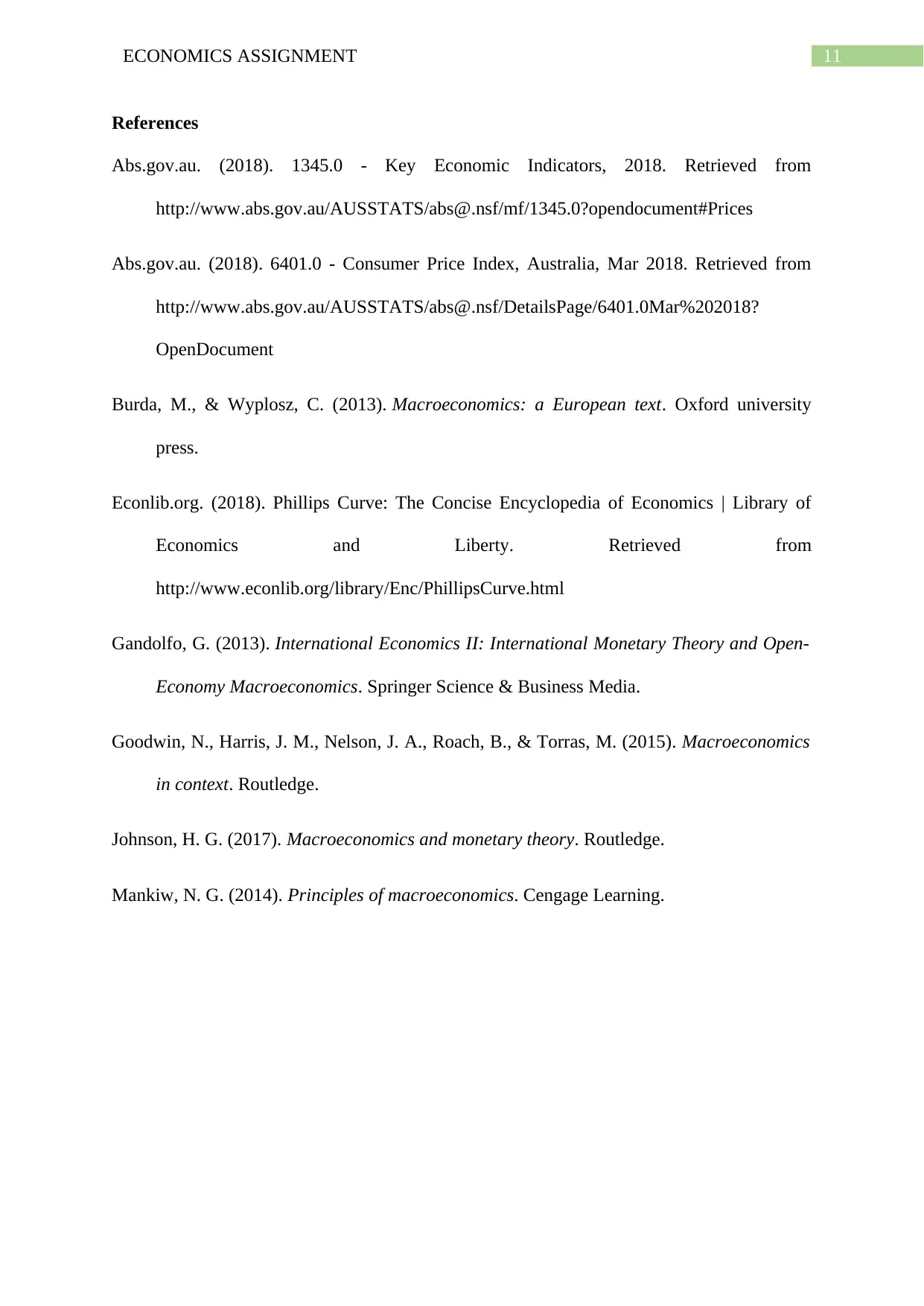
11ECONOMICS ASSIGNMENT
References
Abs.gov.au. (2018). 1345.0 - Key Economic Indicators, 2018. Retrieved from
http://www.abs.gov.au/AUSSTATS/abs@.nsf/mf/1345.0?opendocument#Prices
Abs.gov.au. (2018). 6401.0 - Consumer Price Index, Australia, Mar 2018. Retrieved from
http://www.abs.gov.au/AUSSTATS/abs@.nsf/DetailsPage/6401.0Mar%202018?
OpenDocument
Burda, M., & Wyplosz, C. (2013). Macroeconomics: a European text. Oxford university
press.
Econlib.org. (2018). Phillips Curve: The Concise Encyclopedia of Economics | Library of
Economics and Liberty. Retrieved from
http://www.econlib.org/library/Enc/PhillipsCurve.html
Gandolfo, G. (2013). International Economics II: International Monetary Theory and Open-
Economy Macroeconomics. Springer Science & Business Media.
Goodwin, N., Harris, J. M., Nelson, J. A., Roach, B., & Torras, M. (2015). Macroeconomics
in context. Routledge.
Johnson, H. G. (2017). Macroeconomics and monetary theory. Routledge.
Mankiw, N. G. (2014). Principles of macroeconomics. Cengage Learning.
References
Abs.gov.au. (2018). 1345.0 - Key Economic Indicators, 2018. Retrieved from
http://www.abs.gov.au/AUSSTATS/abs@.nsf/mf/1345.0?opendocument#Prices
Abs.gov.au. (2018). 6401.0 - Consumer Price Index, Australia, Mar 2018. Retrieved from
http://www.abs.gov.au/AUSSTATS/abs@.nsf/DetailsPage/6401.0Mar%202018?
OpenDocument
Burda, M., & Wyplosz, C. (2013). Macroeconomics: a European text. Oxford university
press.
Econlib.org. (2018). Phillips Curve: The Concise Encyclopedia of Economics | Library of
Economics and Liberty. Retrieved from
http://www.econlib.org/library/Enc/PhillipsCurve.html
Gandolfo, G. (2013). International Economics II: International Monetary Theory and Open-
Economy Macroeconomics. Springer Science & Business Media.
Goodwin, N., Harris, J. M., Nelson, J. A., Roach, B., & Torras, M. (2015). Macroeconomics
in context. Routledge.
Johnson, H. G. (2017). Macroeconomics and monetary theory. Routledge.
Mankiw, N. G. (2014). Principles of macroeconomics. Cengage Learning.
⊘ This is a preview!⊘
Do you want full access?
Subscribe today to unlock all pages.

Trusted by 1+ million students worldwide
1 out of 12
Related Documents
Your All-in-One AI-Powered Toolkit for Academic Success.
+13062052269
info@desklib.com
Available 24*7 on WhatsApp / Email
![[object Object]](/_next/static/media/star-bottom.7253800d.svg)
Unlock your academic potential
Copyright © 2020–2025 A2Z Services. All Rights Reserved. Developed and managed by ZUCOL.





